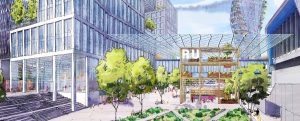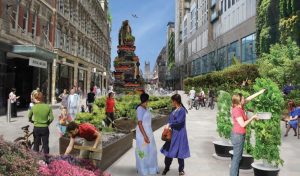By Professor Tim Dixon, School of the Built Environment, University of Reading

As the world’s urban population continues to grow, it will be increasingly important for the built environment sector to offer solutions that work for individual streets as well as whole cities.
Buildings already make up 20% of global emissions, and the world’s population will be 70% urban by 2050. So, understanding how we can join up our thinking and disciplinary understanding from individual building level to neighbourhood level and at the urban level will be essential to make the built environment work better for society and create more resilient and sustainable places.
In short, this means developing the ability to integrate our actions so that we can mobilise support from building owners and occupiers, communities, and city stakeholders across these different scales.
Smart, resilient and sustainable
Four new research-based books from authors in the School of the Built Environment at University of Reading highlight not only the importance of this ‘scale’ issue, but also the need to think about solutions that are ‘smart’ (in terms of the technology that is applied), ‘resilient’ (able to withstand future shocks) and ‘sustainable’ (in terms of the future impact on the environment, economy and people).
For example, in Retrofitting Cities for Tomorrow’s World (Wiley-Blackwell) we highlight the importance of strong governance systems to underpin city level retrofitting of residential, commercial and public buildings in a city. Looking at Cardiff and Greater Manchester the book suggests that compelling city visions need to be developed to mobilise action and that improved modelling and decision-making systems for planning are needed to aid long-term thinking.

The concept of ‘foresight’ or thinking about the future of the built environment is vital therefore, and is a key feature in Sustainable Futures in the Built Environment to 2050: A Foresight Approach to Construction and Development Wiley Blackwell). Our book focuses on both construction and development issues, and examines how we can transition to a sustainable future by the year 2050, bringing together leading research and practice at building, neighbourhood, and city levels. It analyses how emerging socio–economic, technological, and environmental trends will influence the built environment of the future.
This means developing places that have integrated communities; a good and affordable mix of housing; sustainable buildings and infrastructure and transportation systems. But it also means developing our skills to think about what might be termed ‘black swan’ events, such as Brexit and the emergence of Donald Trump.
Human-centred design
However, understanding how to produce productive and sustainable buildings is also important. This is a key message in ‘Creating the Productive Workplace: Places to Work Creatively, 3rd Edition’ (Routledge), which shows how we can help create a world in which health, wellbeing and happiness are integral in our planning, design and management thinking.
The book suggests that not only do we need to balance the needs of people and the ever-increasing enabling technologies, but also to take advantage of the healing powers of nature, all of which should underpin environmental design. The book argues for more human-centred ways of designing the built environment with deeper meaning to help achieve healthier and more creative, as well as more productive, places to work.
The focus on building scale is also highlighted in the international Handbook of Sustainable Real Estate (Routledge) which brings together the latest research of leading academics globally, demonstrating the nature and extent of climate change and resource depletion impacts as well as suggesting the most effective means of mitigating climate change impact and building resilience to future shocks by developing and constructing more sustainable buildings.
As Sir David King notes in the foreword to Retrofitting Cities for Tomorrow’s World:
“We now live in a globalised world where local and global issues are inextricably linked. More than ever, there is a need for both national government and city administrations to work together, thinking of cities not as a series of discrete services – energy, transport, healthcare and so on – but as a constellation of systems that must work together, with policies and regulations in place to encourage them to do so”.
Understanding the scale issue and how to apply our knowledge and skills across buildings, neighbourhoods and cities are therefore critical to success in planning and managing a transition to a sustainable built environment.
